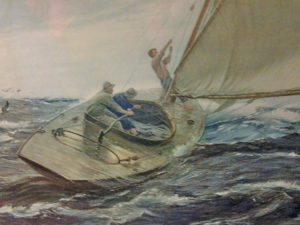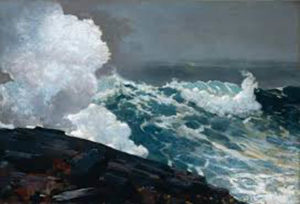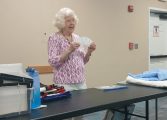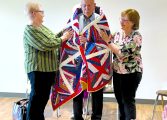Artists share their inspirations
By Page H. Gifford, Correspondent
Members of Fluvanna’s art community recently took time to discuss their favorite artists.
A consensus emerged: American artists Andrew Wyeth and Winslow Homer were among the favorites, though there were many surprises as to which artists and styles inspired them.
Wyeth has a haunting and stark realism in his work – a style that made him a leading exponent of his generation. In depicting everyday life in New England, Homer recorded simple scenes and subjects in a memorable style and became revered as one of the great American masters.
Many of the great artists learned to manipulate color and light to create certain moods in their work. They also experimented and explored, working progressively and never compromising.
 Artist Troy Weidenheimer believes in capturing the true nature of the subjects he paints.
Artist Troy Weidenheimer believes in capturing the true nature of the subjects he paints.
“At the moment I’d say Charles Napier Hemy, a European realist marine painter, working around 1900… And several modern Chinese artists like the wonderful Liu Yi, are among my favorites,” he said. Like Homer, Hemy, a British painter, captured the day-to-day scenes of life on the coast of England in realistic detail. His depiction of light as seen in the sky or in shallow waters is so vivid that it draws the onlooker in as if she is standing right beside the subjects.
Weidenheimer has a great admiration for Asian artists. The apparent realism of Liu Yi’s work is subtler with a soft, light touch. His subjects are wispy, almost ethereal.
Liz Ellis, who has been known for her portraits of animals, was one of the fans of Wyeth.
“I chose Andrew Wyeth because I love the realism of his work and the subjects,” she said. “I love the softness of his colors and of course the way he handles the light. It really is all about light and shadows, isn’t it?”
On a more contemporary note, Ellis mentioned Doug Dawson, a pastel artist: “I really admire the clear, brighter colors of Dawson. His style is so different from Wyeth in that he is not as controlled. Two very different artists; both so inspiring.”
Watercolorist Linda Bethke cited the late-19th century Russian painter Ivan Aivazovsky and Americana-German painter Albert Bierstadt as her favorite artists. This is an eye-opener when seeing Bethke’s own work, which is the total opposite of those she admires. Her watercolors are bright and cheerful, while Bierstadt and Aivazovsky are vastly different in style with subtle and often dark colors, and muted blending portraying landscapes.
Susan Lang named Caravaggio and Joaquín Sorolla among a few artists she looks to for inspiration.
“These two artists’ lives were separated by over 300 years. Caravaggio’s paintings have extremely dark shadows and the subjects glow in bright shafts of light creating such a dramatic contrast, I find them captivating,” she said. “Sorolla’s paintings capture light in a different way; bright sun light shimmers in his depiction of people along the shore. My favorite is Mending the Sails. The light dances over the canvas.” She also added Edward Hopper for his “simplistic compositions that tell complex stories.”
Tom Tartaglino, who works in large scale oils, often engaging in plein air painting of scenes in Virginia and elsewhere, stated Winslow Homer and Andrew Wyeth as topping his list of favorite artists.
“Although I am partial to Eric Fischl and Gustav Dore,” he added. Fischl’s paintings are often realistic and offbeat, with many figures, mostly nude, and contain an underlying statement about human nature. Dore’s illustrations featured detailed pen and ink drawings of fantasy and lore.
“There are many artists I admire from the Renaissance on, including Italians like da Vinci and Caravaggio, and Dutch masters like Rembrandt and Vermeer,” said watercolor landscape artist William Snow. “I am also a big fan of Degas, Renoir, O’Keefe, Louise Nevelson and others.” When it comes to watercolor, John Singer Sargent, Winslow Homer, Andrew Wyeth, John Pike, Edgar Whitney, and Murray Wentworth influenced Snow.
 “A master at plein air watercolors, Sargent’s superb compositions are bold, simple and fresh. His brush strokes, along with his use of light, set the standard for watercolor as a sketching medium,” said Snow. “Winslow Homer’s simple yet pleasing compositions” strike him, he said. “The animated employ of human figures and subtle use of color mark Homer’s expert ability with a difficult medium, and Wyeth’s ability to mix quick, loose passages with dry brush detail mark his unparalleled ability at study and observation.”
“A master at plein air watercolors, Sargent’s superb compositions are bold, simple and fresh. His brush strokes, along with his use of light, set the standard for watercolor as a sketching medium,” said Snow. “Winslow Homer’s simple yet pleasing compositions” strike him, he said. “The animated employ of human figures and subtle use of color mark Homer’s expert ability with a difficult medium, and Wyeth’s ability to mix quick, loose passages with dry brush detail mark his unparalleled ability at study and observation.”
The methods of more contemporary watercolor artists that are closely related to Snow’s own work are seen in the wet-on-wet techniques of artists like John Pike and Edgar Whitney.
“Great wet-on-wet color layering techniques and a wonderful sense of directional light are some of Pike’s foremost attributes,” he said. “Whitney was masterful at strong design, broad, single passages and wet-on-wet color diffusion. A great teacher as well.”
Snow studies his artists with utmost detail and scrutiny. “Little known in watercolor circles today, Wentworth worked fast and loose on smooth, hot press surfaces,” he said. “His ability to pull and rub out color, along with his mastery of splatter and scratch out techniques to create texture, give his landscapes an immediacy and spontaneity admired by many who knew him.”
Those we admire or who inspire us may be far removed from our own style, but if the onlooker peers at the work more closely, the subtle nuances of that admiration and inspiration can be seen in these artists’ work.




